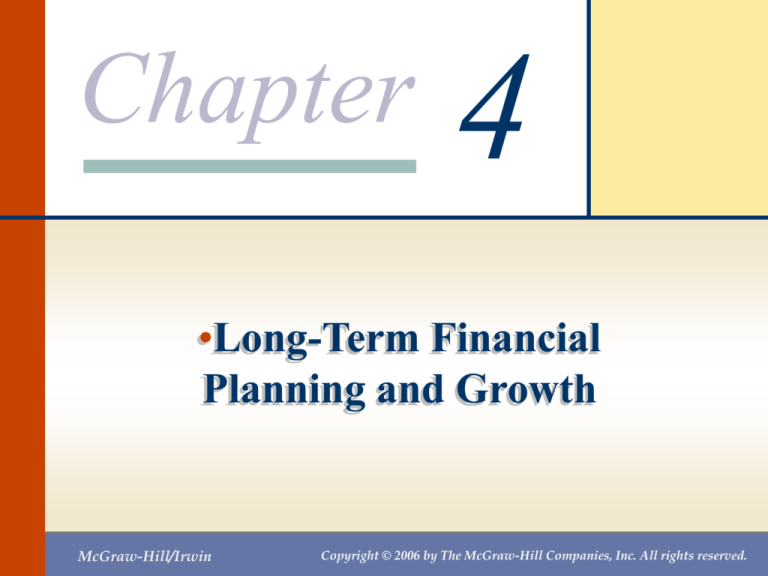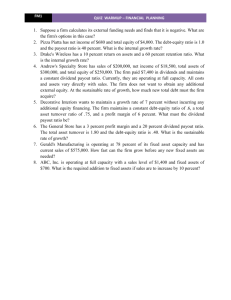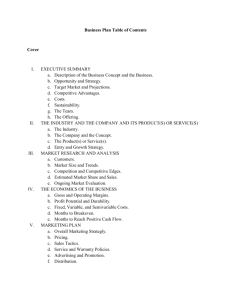
Chapter
4
•Long-Term Financial
Planning and Growth
McGraw-Hill/Irwin
Copyright © 2006 by The McGraw-Hill Companies, Inc. All rights reserved.
Chapter 04– Index of Sample
Problems
•
•
•
•
•
•
•
•
Slide # 02 - 05
Slide # 06 - 08
Slide # 09 - 13
Slide # 14 - 16
Slide # 17 - 23
Slide # 24 - 27
Slide # 28 - 29
Slide # 30 - 34
Plowback and dividend payout ratios
Constant growth planning
Percentage of sales planning
External financing need
Pro forma with external financing
Capacity level
Internal growth
Sustainable growth
Dimensions of Financial planning
• Planning horizon
• Aggregation
• Scenario approach: worst, normal, best
cases
Accomplishment
•
•
•
•
Examining interaction
Exploring options
Avoiding surprises
Ensuring feasibility and internal consistcy
Ingredients of financial planning
model
•
•
•
•
•
•
Sales forecast
Pro forma statement
Asset requirement
Financial requirement
The plug
Economic assumption (interest rate, tax rate)
2: Plowback and dividend payout
ratios
Your company has net income of $1,600 for the year. You paid out
$400 in dividends to your stockholders.
What is the dividend payout ratio?
What is the plowback ratio?
What is the dollar increase in retained earnings?
3: Plowback and dividend payout
ratios
Your company has net
income of $1,600 for the
year. You paid out $400 in
dividends to your
stockholders.
Cash dividends
Net income
$400
$1,600
.25
Dividend payout ratio
Plowback ratio 1 - dividend payout ratio
1 - .25
.75
Addition t o retained earnings Net income plowback ratio
$1,600 .75
$1,200
4: Plowback and dividend payout
ratios
This year your company expects net income of $2,800. You now
adhere to a 60% plowback ratio.
What is the expected dollar increase in retained earnings?
How much do you expect to pay in dividends?
What is the dividend payout ratio?
5: Plowback and dividend payout
ratios
This year your company
expects net income of
$2,800. You now adhere
to a 60% plowback ratio.
Addition t o retained earnings Net income plowback ratio
$2,800 .60
$1,680
Dividends paid Net income Addition t o retained earnings
$2,800 $1,680
$1,120
Cash dividends
Net income
$1,120
$2,800
40%
Dividend payout ratio
6: Constant growth planning
You expect your sales, costs and assets to grow by 10% next
year. You will not pay any dividends. Can you complete the pro
forma statement? Round all amounts to whole dollars.
Income Statement
Current Projected
Sales
$800
$_______
Costs
$700
$_______
Taxable income
$100
$_______
Taxes (34%)
$ 34
$_______
Net income
$ 66
$_______
Balance Sheet
Assets
Current
$400
Projected
$_______
Total
$400
$_______
Debt
Equity
Total
Current
$150
$250
$400
Projected
$_______
$_______
$_______
7: Constant growth planning
The computations are shown on the next slide.
Income Statement
Current Projected
Sales
$800
$880
Costs
$700
$770
Taxable income
$100
$110
Taxes (34%)
$ 34
$ 37
Net income
$ 66
$ 73
Balance Sheet
Assets
Current
$400
Projected
$440
Total
$400
$440
Debt
Equity
Total
Current
$150
$250
$400
Projected
$117
$323
$440
8: Constant growth planning
Step 1
Step 3
Sales $800(1.10) $880
Costs $700(1.10) $770
Taxes $34(1.10) $37( rounded )
Assets $400(1.10) $440
Step 2
Total liabilitie s equity Total assets
$440
Step 4
Projected equity Current equity Projected net income
$250 $73
$323
Debt (Total liabilitie s equity) - equity
$440 - $323
$117
9: Percentage of sales planning
The assets and current liabilities of Jennings, Inc. vary in direct
proportion to the increase in sales. The current sales are $2,000
and you expect them to increase by 20% next year. Net income is
projected at 5% of sales. The firm is not planning on issuing any
more common stock nor paying any dividends.
Using this information, can you compile the pro forma balance
sheet shown on the next slide?
10: Percentage of sales planning
Current
% of sales
Projected
Cash
Accounts receivable
Inventory
Fixed assets
Total assets
$ 120
$ 500
$ 840
$2,600
$4,060
_____%
_____%
_____%
_____%
_____%
$_______
$_______
$_______
$_______
$_______
Accounts payable
Long-term debt
Common stock and paid in surplus
Retained earnings
Total liabilities and equity
$ 600
$ 700
$1,000
$1,760
$4,060
_____%
_____%
_____%
_____%
_____%
$_______
$_______
$_______
$_______
$_______
Refer to the prior slide for information pertaining to this problem.
Enter n/a where the % of sales does not apply.
11: Percentage of sales planning
Current
% of sales
Projected
Cash
Accounts receivable
Inventory
Fixed assets
Total assets
$ 120
$ 500
$ 840
$2,600
$4,060
6%
25%
42%
130%
203%
$ 144
$ 600
$1,008
$3,120
$4,872
Accounts payable
Long-term debt
Common stock and paid in surplus
Retained earnings
Total liabilities and equity
$ 600
$ 700
$1,000
$1,760
$4,060
30%
n/a
n/a
n/a
n/a
$ 720
$1,272
$1,000
$1,880
$4,872
See the next slide for the computations
12: Percentage of sales planning
Step 1
Step 2
$120
$2,000
$500
$2,000
$840
$2,000
$2,600
$2,000
$4,060
$2,000
$600
$2,000
Cash
Accounts receivable
Inventory
Fixed assets
Total assets
Accounts payable
.06 6%
Sales $2,000 1.20 $2,400
.25 25%
Cash .06 $2,400 $144
.42 42%
Accounts receivable .25 $2,400 $600
1.30 130%
Inventory .42 $2,400 $1,008
2.03 203%
.30 30%
Fixed assets 1.30 $2,400 $3,120
Accounts payable .30 $2,400 $720
Computations continued on next slide
13: Percentage of sales planning
Step 3
Common stock $1,000 $0 $1,000
Retained earnings $1,760 ( .05 $2,400) $1,880
Total liabilitie s and owners' equity Total assets $4,872
Step 4
Total liabilities and owners’ equity
Accounts payable
Common stock and paid in surplus
Retained earnings
Long-term debt
$4,872
-$ 720
-$1,000
-$1,880
$1,272
14: External financing need
You project your sales will increase by $3,000 next year. Net
income is 10% of sales and accounts payable is 25% of sales. The
capital intensity ratio is 2.5. No dividends are anticipated.
How much external financing is needed to fund this growth?
Try to solve this problem without looking at the hints on the next
slide.
15: External financing need
You project your sales will increase by $3,000 next year. Net
income is 10% of sales and accounts payable is 25% of sales. The
capital intensity ratio is 2.5. No dividends are anticipated.
How much external financing is needed to fund this growth?
Hints:
Step 1: Compute the increase in total assets
Step 2: Compute the increase in accounts payable
Step 3: Compute the increase in retained earnings
Step 4: Compute the additional long-term debt and equity
financing that is needed
16: External financing need
Step 1
Step 2
Total assets Sales Capital intensity ratio
$3,000 2.5
$7,500
Accounts payable .25 Sales
.25 $3,000
$750
Step 3
Addition t o retained earnings Net income - Dividends paid
( .10 sales) - 0
.10 $3,000
$300
Step 4
External financing need Total assets - Accounts payable - Additions to retained earnings
$7,500 - $750 - $300
$6,450
17: Pro forma with external financing
Your firm currently has long-term debt of $4,400, common stock
and paid in surplus of $10,000 and retained earnings of $4,600. The
capital intensity ratio is 2.2 and the tax rate is 35%. Costs are 72%
of sales and accounts payable are 30% of sales. Sales currently are
$10,000 and are expected to increase by 10% next year. The
dividend payout ratio is 20%. Long-term debt will be used to fund
40% of the external funding need.
Given this information, can you complete the pro forma financial
statements on the next slide?
18: Pro forma with external financing
Round all amounts to whole dollars.
Pro forma Income Statement
Sales
Costs
Taxable income
Taxes (35%)
Net Income
Assets
Total
$______
$______
$______
$______
$______
Pro forma Balance Sheet
$______
Accounts payable
Long-term debt
Common stock
Retained earnings
$______
Total
$______
$______
$______
$______
$______
19: Pro forma with external financing
The computations are shown on the next four slides.
Pro forma Income Statement
Sales
Costs
Taxable income
Taxes (35%)
Net Income
Assets
Total
$11,000
$ 7,920
$ 3,080
$ 1,078
$ 2,002
Pro forma Balance Sheet
$24,200
Accounts payable
Long-term debt
Common stock
_______
Retained earnings
$24,200
Total
$ 3,300
$ 4,519
$10,179
$ 6,202
$24,200
20: Pro forma with external financing
Sales $10,000 1.10 $11,000
Costs .72 $11,000 $7,920
Taxable income $11,000 - $7,920 $3,080
Tax .35 $3,080 $1,078
Net income $3,080 - $1,078 $2,002
21: Pro forma with external financing
Total assets 2.2 $11,000 $24,200
Accounts payable .30 $11,000 $3,300
Plow back ratio 1 - Dividend payout ratio 1 - .20 .80
Retained earnings $4,600 (Plowback ratio Net income) $4,600 (.80 $2,002) $6,202 (rounded )
Total liabilitie s and owners' equity Total assets $24,200
22: Pro forma with external financing
Total liabilities and owners’ equity
Accounts payable
Retained earnings
Current long-term debt
Current common stock
External financing need
$24,200
-$ 3,300
-$ 6,202
-$ 4,400
-$10,000
$ 298
23: Pro forma with external financing
Pro forma long - term debt Current long - term debt (.40 External financing need)
$4,400 (.40 $298)
$4,400 $119 (rounded)
$4,519
Pro forma common stock Current common stock (.60 External financing need)
$10,000 (.60 $298)
$10,000 $179 (rounded)
$10,179
24: Capacity level
Your firm has fixed assets of $28,000 and is operating at 80% of
capacity. Current sales are $18,000.
What is the full-capacity sales level?
What is the capital intensity ratio at the full-capacity sales level?
25: Capacity level
Your firm has fixed
assets of $28,000 and is
operating at 80% of
capacity. Current sales
are $18,000.
Full - capacity sales
Current sales
Current operating level
$18,000
.80
$22,500
Fixed assets
Full - capacity sales
$28,000
$22,500
1.24 (rounded )
Full capacity capital intensity ratio
26: Capacity level
Your firm has projected sales of $1,600. The capital intensity ratio
at the full-capacity sales level of $1,900 is 1.20. Ignoring the
capacity level, you have projected net fixed assets at $2,100 and
the external financing need at $1,000.
What is the external financing need if the capacity level is
considered?
27: Capacity level
Your firm has projected sales of $1,600. The capital intensity ratio at the
full-capacity sales level of $1,900 is 1.20. Ignoring the capacity level, you
have projected net fixed assets at $2,100 and the external financing need
at $1,000. What is the external financing need if the capacity level is
considered?
Fixed assets needed Sales Capital intensity ratio
$1,600 1.2
$1,920
Excess estimate Fixed assets projected - Fixed assets needed
$2,100 - $1,920
$180
Actual external financing need Projected external financing need - Excess estimate
$1,000 - $180
$820
28: Internal growth
Your firm has net income of $6,000 and total assets of $30,000.
The dividend payout ratio is 40%.
What is the internal growth rate?
29: Internal growth
Net income
Total assets
$6,000
$30,000
.20
Return on assets
Your firm has net
income of $6,000 and
total assets of $30,000.
The dividend payout
ratio is 40%. What is the
internal growth rate?
Plowback ratio 1 - Dividend payout ratio
1 - .40
.60
ROA b
1 - ROA b
.20 .60
1 .20 .60
.12
.88
.1364(rounded )
13.64%
Internal growth rate
30: Sustainable growth
A firm has net income of $2,000 and pays $400 in dividends. Total
equity is $8,000.
What is the sustainable growth rate?
31: Sustainable growth
A firm has net income of $2,000
and pays $400 in dividends.
Total equity is $8,000. What is
the sustainable growth rate?
Step 3
Net income
Total equity
$2,000
$8,000
.25
Return on equity
Step 1
Cash dividends
Net income
$400
$2,000
.20
Dividend payout ratio
Step 2
Plowback ratio 1 - Dividend payout ratio
1 - .20
.80
Step 4
ROE b
1 - ROE b
.25 .80
1 .25 .80
.20
.80
.25
25%
Sustainabl e growth rate
32: Sustainable growth
Your firm has a 10% net profit margin and a dividend payout ratio
of 25%. The debt-equity ratio is 40% and the total asset turnover
rate is 2.
What is the sustainable rate of growth?
33: Sustainable growth
Your firm has a 10% net profit margin and a dividend payout ratio
of 25%. The debt-equity ratio is 40% and the total asset turnover
rate is 2. What is the sustainable rate of growth?
Hints:
Step 1. Find the equity multiplier using the debt-equity ratio
Step 2. Compute the ROE using the DuPont formula
Step 3. Find the plowback ratio using the dividend payout ratio
Step 4. Compute the sustainable growth rate
34: Sustainable growth
Your firm has a 10% net profit
margin and a dividend payout
ratio of 25%. The debt-equity
ratio is 40% and the total asset
turnover rate is 2.
Step 1
Equity multiplier 1 Debt - equity ratio
1 .40
1.40
Step 2
ROE PM TAT EM
.10 2 1.40
.28
Step 3
Plowback ratio 1 - Dividend payout ratio
1 - .25
.75
Step 4
ROE b
1 - ROE b
.28 .75
1 .28 .75
.21
.79
.2658(rounded )
26.58%
Sustainabl e growth rate
Chapter
4
•End of Chapter 4
McGraw-Hill/Irwin
Copyright © 2006 by The McGraw-Hill Companies, Inc. All rights reserved.





